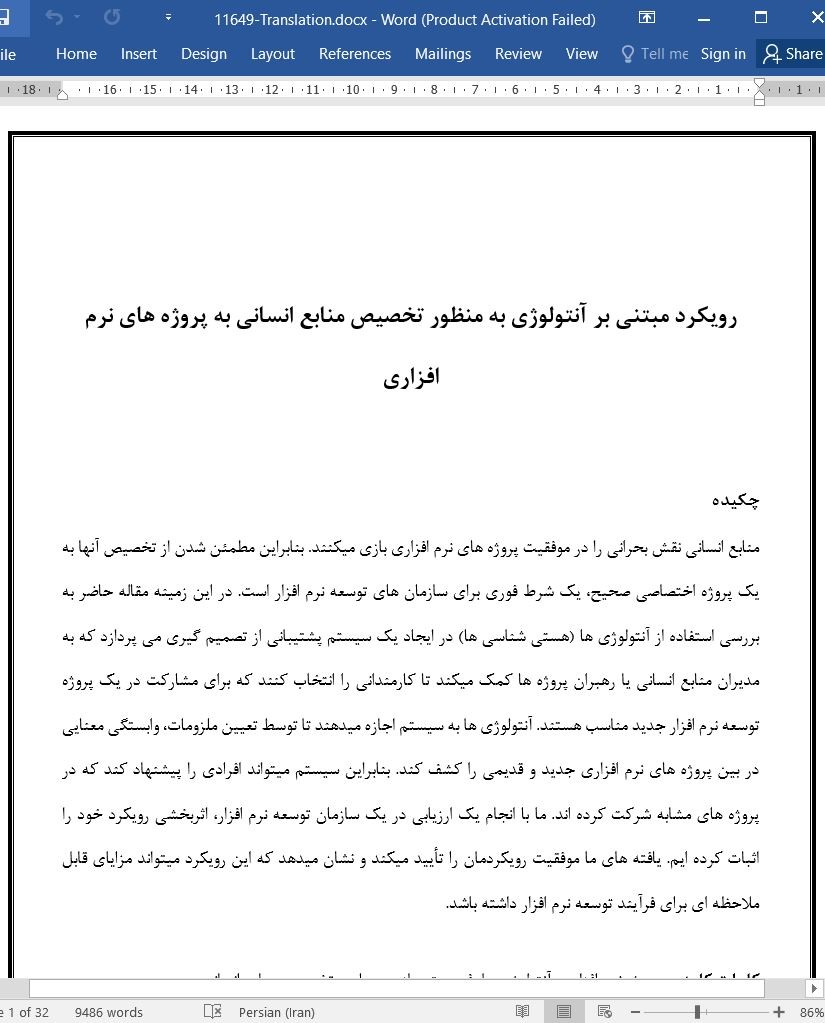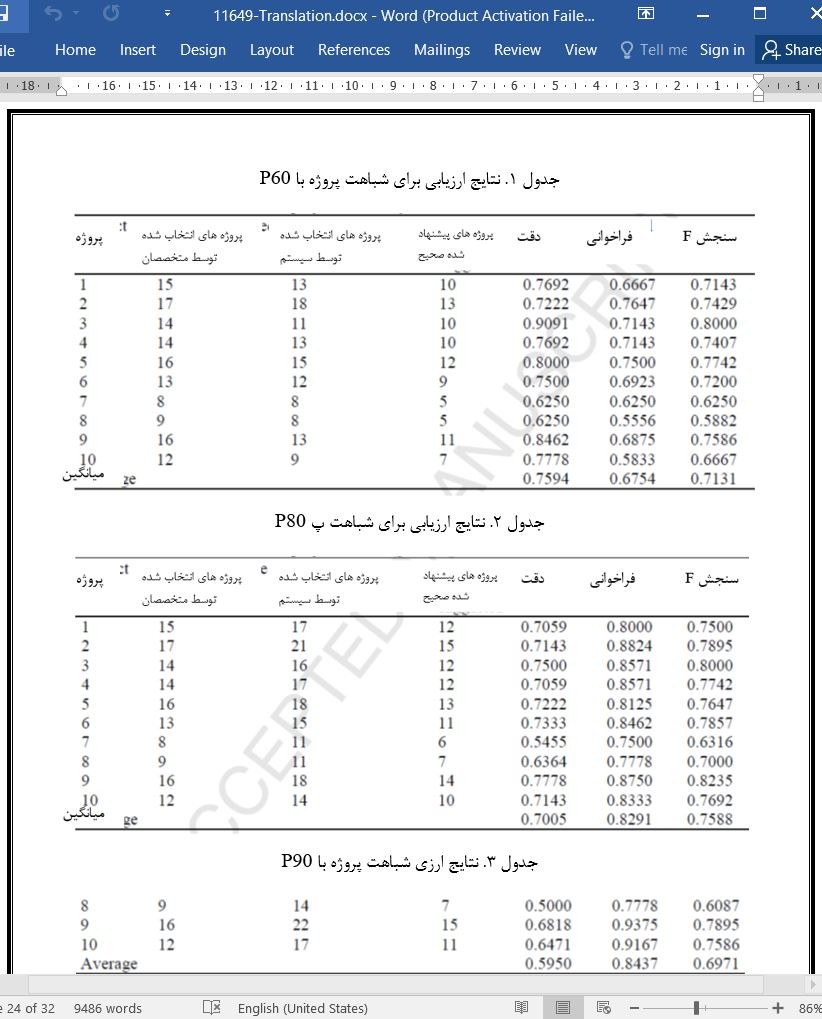
رویکرد مبتنی بر آنتولوژی به منظور تخصیص منابع انسانی به پروژه های نرم افزاری
چکیده
منابع انسانی نقش بحرانی را در موفقیت پروژه های نرم افزاری بازی میکنند. بنابراین مطمئن شدن از تخصیص آنها به یک پروژه اختصاصی صحیح، یک شرط فوری برای سازمان های توسعه نرم افزار است. در این زمینه مقاله حاضر به بررسی استفاده از آنتولوژی ها (هستی شناسی ها) در ایجاد یک سیستم پشتیبانی از تصمیم گیری می پردازد که به مدیران منابع انسانی یا رهبران پروژه ها کمک میکند تا کارمندانی را انتخاب کنند که برای مشارکت در یک پروژه توسعه نرم افزار جدید مناسب هستند. آنتولوژی ها به سیستم اجازه میدهند تا توسط تعیین ملزومات، وابستگی معنایی در بین پروژه های نرم افزاری جدید و قدیمی را کشف کند. بنابراین سیستم میتواند افرادی را پیشنهاد کند که در پروژه های مشابه شرکت کرده اند. ما با انجام یک ارزیابی در یک سازمان توسعه نرم افزار، اثربخشی رویکرد خود را اثبات کرده ایم. یافته های ما موفقیت رویکردمان را تأیید میکند و نشان میدهد که این رویکرد میتواند مزایای قابل ملاحظه ای برای فرآیند توسعه نرم افزار داشته باشد.
1. مقدمه
در صنعت، فرآیند توسعه نرم افزاری همیشه نیازمند بهبود بوده است اما این نیاز در شرایط اقتصادی فعلی شدیدتر نیز شده است چون سازمان های توسعه نرم افزاری روز به روز تکنیک های بهتری را تقاضا میکنند که علاوه بر عواملی مانند بودجه و زمان، شایستگی های پرسنل خود را نیز مد نظر قرار دهند. اصطلاح شایستگی در اینجا به معنای داشتن صلاحیت و شرایط لازم است [1]. منابع انسانی نقش بحرانی را در موفقیت پروژه های نرم افزاری بازی میکنند [2, 3]. بنابراین اطمینان حاصل کردن از تخصیص صحیح یک پروژه نرم افزاری خاص، یک شرط لازم و فوری برای سازمان های توسعه نرم افزار است. تیم های توسعه نرم افزار در حال حاضر بر اساس تجربیات مدیران منابع انسانی در مورد «افراد، محدودیت ها (بعنوان مثال دسترس پذیری)، و ملزومات مهارت» تشکیل میشوند اما این تجربیات بصورت سیستماتیک ثبت نمیشود [4]. این تکنیک در سازمان های بزرگتر و SME ها (شرکت هایی با اندازه های کوچک و متوسط) پیچیده تر و حتی غیرممکن میشود چون تعداد کارمندان آنها زیاد است.
5. نتیجه گیری ها
ما در تحقیق حاضر یک سیستم مبتنی بر معنا را معرفی کرده ایم که قادر است با بررسی تجربیات قبلی پرسنل در پروژه های قبلی پیشنهاد کند کدامیک از آنها در یک پروژه نرم افزاری جدید شرکت کنند. پیشنهاد ما نتایج امیدبخشی را نشان داد: امتیازات سنجش F برابر با 0.7131 (P60)، 0.7588 (P80) و 0.6971 (P90) برای پروژه های شباهت، و امتیازات دقت برابر با 0.6127 (P60) و 0.7382 (P80, P90) برای پیشنهاد پرسنل. کمک اصلی تحقیق حاضر به این زمینه، دو مورد است. اول اینکه ما یک آنتولوژی متمرکز بر توصیف شایستگی ها و تجربیات پرسنل در یک سازمان را پیشنهاد کرده ایم. دوم اینکه یکپارچه سازی تکنیک های معنایی با فرآیند تخصیص پرسنل در یک سازمان توسعه نرم افزار میتواند به مدیر منابع انسانی کمک کند تا سرعت این کار را افزایش دهد و حتی آنرا کاملاً اتوماتیک سازد. و علاوه بر همه اینها، سطح بالایی از اطمینان نیز وجود دارد که پرسنل انتخاب شده توسط سیستم برای انجام پروژه مناسب تر هستند. بعلاوه روش پیشنهاد شده در اینجا را میتوانیم برای فرآیند توسعه نرم افزار جاری سازمان مورد استفاده قرار دهیم بدون اینکه مجبور باشیم هر گونه تغییری را در آن انجام دهیم. بعلاوه رویکرد ما بصورتی طراحی شده است که از دامنه مستقل باشد؛ بعبارت دیگر میتوانیم سیستم خود را در سازمان های مختلف اجرا کنیم و تنها شرط آن این است که یک آنتولوژی برای سیستم فراهم گردد که زمینه متناظر را مدلسازی میکند. مهم است تأکید کنیم که اضافه سازی تکنولوژی های معنای به پروژه به بهبود کیفیت و سازگاری داده ها کمک میکند و بنابراین به ما اجازه میدهد تا این اطلاعات را برای اهداف دیگری نیز مورد استفاده قرار دهیم چون یکی از اهداف اصلی semantic web (وب معنایی) و خصوصاً آنتولوژی ها این است که بصورت مرجعی برای ارتباط بین انسان ها و همچنین ارتباط بین کامپیوترها عمل کنند.
Abstract
Human resources play a critical role in the success of software projects. Ensuring the correct assignment of them to a specific project is, therefore, an immediate requirement for Software development organizations. Within this context, this work explores the use of ontologies in the building of a decision support system that will help human resources managers or project leaders to select those employees who are best suited to participating in a new software development project. Ontologies allow the system to discover semantic relatedness among new and previous software projects by means of its requirements specification. The system can, therefore, suggest those people who have participated on similar projects. We have proved the effectiveness of our approach by conducting an evaluation in a software development organization. Our findings confirm the success of our approach and reveal that it may bring considerable benefits to the software development process.
1. Introduction
The need for software development process improvement has always existed in industry, but it has become even more pressing within the current economic context, since software development organizations are increasingly demanding better practices that consider not only factors such as budget and time, but also the competencies of their personnel. The term competence refers to the state or quality of being adequately or well qualified [1]. Human resources play a critical role in the success of software projects [2], [3] and ensuring their correct assignment to a specific software project is, therefore, an immediate requirement to which software development organizations must pay special attention. Software development teams are currently formed on the basis of human resources managers’ experience of people, constraints (e.g. availability), and skill requirements, but this experience is not systematically recorded [4]. This practice becomes more complex and even impossible in large organizations and SMEs (Small and Medium-sized Enterprises) owing to the number of employees that are available.
5. Conclusions
In this piece of research, we have presented a semantic-based system that is able to suggest which personnel could be incorporated into a new software project by considering their experience on previous projects. Our proposal obtained encouraging results with F-measure scores of 0.7131 (P60), 0.7588 (P80), and 0.6971 (P90) for similarity projects and precision scores of 0.6127 (P60) and 0.7382 (P80 and P90) for personnel suggestion. The main contribution of our research effort is twofold. First, we propose an ontology focused on describing the competences and experience of the personnel within an organization. Second, the integration of semantic techniques to the personnel assignment process within a software development organization can help the human resources manager to speed up this task, and even make it completely automated. And all of this in addition to a high level of confidence that the personnel selected by the system are the most appropriate for the project. Moreover, the method proposed herein can be applied to the organization’s current software development process without any changes having to be made to it. Furthermore, our approach has been designed to be domain-independent, i.e. our system can be implemented in different organizations with the only requirement that the system be provided with an ontology that models the corresponding context. It is important to stress that the incorporation of semantic technologies into the project helps to improve data quality and consistency, thus allowing this information to be used for other purposes, since one of the main goals of the semantic web, and more specifically of ontologies, is for them to serve as a reference for communication not only among humans but also among computers.
چکیده
1. مقدمه
2. مقالات مرتبط
3. معماری سیستم
3.1 منابع اطلاعاتی
3.2 انبار آنتولوژی
3.3 مدول فهرست سازی معنایی
3.4 مدول پشتیبانی از تصمیم گیری
4. مطالعه موردی
4.1 روش
4.2 بحث
5. نتیجه گیری ها
منابع
Abstract
1. Introduction
2. Related work
3. System architecture
3.1 Information resources
3.2. Ontology repository
3.3. Semantic indexing module
3.4. Decision support module
4. Case study
4.1. Method
4.2. Discussion
5. Conclusions
References
- اصل مقاله انگلیسی با فرمت ورد (word) با قابلیت ویرایش
- ترجمه فارسی مقاله با فرمت ورد (word) با قابلیت ویرایش، بدون آرم سایت ای ترجمه
- ترجمه فارسی مقاله با فرمت pdf، بدون آرم سایت ای ترجمه



